A level biology cofactors - Study guides, Revision notes & Summaries
Looking for the best study guides, study notes and summaries about A level biology cofactors? On this page you'll find 37 study documents about A level biology cofactors.
Page 2 out of 37 results
Sort by

-
Biochemistry Test 1 Questions and Answers Graded A+
- Exam (elaborations) • 28 pages • 2023
-
- £8.12
- + learn more
Biochemistry Test 1 Questions and Answers Graded A+ biochemistry a discipline in biochemistry; is the description of molecules in biology/chemistry of proteins molecular biology a discipline in biochemistry; the manipulation of DNA, genetics cell biology a discipline in biochemistry; larger scale, functions and mechanisms within a cell/cell energetics cellulose a natural polymer; found in plants for storage glycogen a natural polymer; found in animals for storage protein a natural polymer; ...
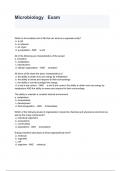
-
Microbiology Exam
- Exam (elaborations) • 43 pages • 2023
-
- £16.25
- + learn more
Microbiology Exam Which is the smallest unit of life that can exist as a separate entity? a. a cell b. a molecule c. an organ d. a population - ANS a cell All of the following are characteristics of life except a. ionization. b. metabolism. c. reproduction. d. cellular organization. - ANS ionization All forms of life share the basic characteristics of a. the ability to obtain and use energy by metabolism. b. the ability to sense and respond to...
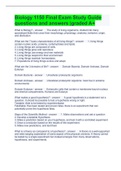
-
Biology 1150 Final Exam Study Guide questions and answers |graded A+
- Exam (elaborations) • 11 pages • 2023
- Available in package deal
-
- £14.22
- + learn more
Biology 1150 Final Exam Study Guide questions and answers |graded A+ What is Biology? The study of living organisms, divided into many specialized fields that cover their morphology, physiology, anatomy, behavior, origin, and disribution What are the 7 basic characteristics of all living things? 1. living things contain nucleic acids, proteins, carbohydrates and lipids. 2. Living things are composed of cells. 3. Living things grow and reproduce 4. Living things use energy and raw ma...

-
Biochemistry Test 1 questions and answers
- Exam (elaborations) • 12 pages • 2023
- Available in package deal
-
- £15.84
- + learn more
Biochemistry Test 1 questions and answers biochemistry a discipline in biochemistry; is the description of molecules in biology/chemistry of proteins molecular biology a discipline in biochemistry; the manipulation of DNA, genetics cell biology a discipline in biochemistry; larger scale, functions and mechanisms within a cell/cell energetics cellulose a natural polymer; found in plants for storage glycogen a natural polymer; found in animals for storage p...
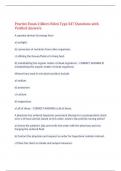
-
Practice Exam 2 Micro Nclex Type 247 Questions with Verified Answers,100% CORRECT
- Exam (elaborations) • 60 pages • 2024
-
- £10.56
- + learn more
Practice Exam 2 Micro Nclex Type 247 Questions with Verified Answers A saprobe derives its energy from a) sunlight. b) conversion of nutrients from other organisms. c) utilizing the tissues/fluids of a living host. d) metabolizing the organic matter of dead organisms. - CORRECT ANSWER d) metabolizing the organic matter of dead organisms. Mineral ions used in microbial nutrition include a) sodium. b) potassium. c) calcium. d) magnesium. e) all of these. - CORRECT ...
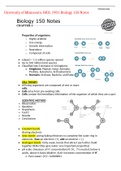
-
University of Minnesota: BIOL 1901 Biology 150 Notes,100% CORRECT
- Lecture notes • 73 pages • 2023
-
- £13.81
- + learn more
University of Minnesota: BIOL 1901 Biology 150 Notes Properties of organisms: o Highly ordered o Use energy o Genetic information o Reproduce o Composed of cells • (about) ~ 1.5 million species named • Up to 100 million total species • Classified into 3 domains or 6 kingdoms o Kingdoms: Plantae, fungi, Animalia, Protista, Eubacteria, Archaebacteria o Domains: Archaea, Bacteria, and Eukarya CELL THEORY • All living organisms are composed of one or more cells. • ...
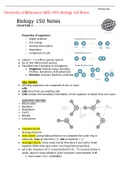
-
University of Minnesota: BIOL 1901 Biology 150 Notes,100% CORRECT
- Lecture notes • 73 pages • 2023
-
- £12.18
- + learn more
University of Minnesota: BIOL 1901 Biology 150 Notes Properties of organisms: o Highly ordered o Use energy o Genetic information o Reproduce o Composed of cells • (about) ~ 1.5 million species named • Up to 100 million total species • Classified into 3 domains or 6 kingdoms o Kingdoms: Plantae, fungi, Animalia, Protista, Eubacteria, Archaebacteria o Domains: Archaea, Bacteria, and Eukarya CELL THEORY • All living organisms are composed of one or more cells. • ...

-
BIO 1305 Final Baylor Questions & Answers
- Exam (elaborations) • 39 pages • 2024
-
- £12.18
- + learn more
Which of the following is the smallest unit of organization that can perform all activities required for life? - ANSWERScell With evolution as the core theme of biology, we can explain traits shared by organisms as evidence of __________ and traits that differ among organisms as evidence of __________. - ANSWERSdescent from a common ancestor; adaptation through natural selection Which series of terms is in the correct sequence of biological organization, from the simplest to the most compl...

-
Enzymes
- Summary • 8 pages • 2023
-
- £5.39
- + learn more
Hand-typed summary notes of Enzymes OCR-A Level Biology Unit 2. Very clear and efficient, providing you with all the key points you need to ace your exam. I achieved an A* in Biology, using these notes! Starts off by explaining the structure of enzymes, before moving onto graphical analysis and explanation of enzyme reactions. Concludes with details on cofactors, coenzyme and inhibition. Written based on text books, classwork sheets and online research. These notes provide an all-in-one pl...
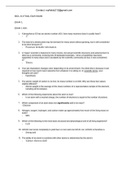
-
BIOL 213 FINAL EXAM BANK:
- Exam (elaborations) • 99 pages • 2022
-
- £10.15
- + learn more
BIOL 213 FINAL EXAM BANK: EXAM 1: EXAM 1 HW: 1. If phosphorus-32 has an atomic number of15, how many neutrons does it usually have? - 17 2. The seed of a desert plant may be dormant for many years without growing, but is still considered to be alive because it? - Possesses heritable information 3. A “rogue” scientist is featured in many movies, but actual scientific discovery and advancement is done as a community, involving lots of dedicated scientists. Once a hypothesis has been supported ...

That summary you just bought made someone very happy. Also get paid weekly? Sell your revision notes on Stuvia! Discover all about earning on Stuvia


